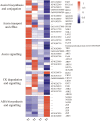Morphological and stage-specific transcriptome analyses reveal distinct regulatory programs underlying yam (Dioscorea alata L.) bulbil growth
- PMID: 31832647
- PMCID: PMC7242083
- DOI: 10.1093/jxb/erz552
Morphological and stage-specific transcriptome analyses reveal distinct regulatory programs underlying yam (Dioscorea alata L.) bulbil growth
Abstract
In yam (Dioscorea spp) species, bulbils at leaf axils are the most striking species-specific axillary structure and exhibit important ecological niches. Genetic regulation underlying bulbil growth remains largely unclear so far. Here, we characterize yam (Dioscorea alata L.) bulbil development using histological analysis, and perform full transcriptional profiling on key developmental stages together with phytohormone analyses. Using the stage-specific scoring algorithm, we have identified 3451 stage-specifically expressed genes that exhibit a tight link between major transcriptional changes and stages. Co-expressed gene clusters revealed an obvious over-representation of genes associated with cell division and expansion at the initiation stage of bulbils (T1). Transcriptional changes of hormone-related genes highly coincided with hormone levels, indicating that bulbil initiation and growth are coordinately controlled by multiple phytohormones. In particular, localized auxin is transiently required to trigger bulbil initiation, and be further depleted or exported from bulbils to promote growth by up-regulation of genes involved in auxinconjugation and efflux. The sharp increase in supply of sucrose and an enhanced trehalose-6-phophate pathway at T1 were observed, suggesting that sucrose probably functions as a key signal and promotes bulbil initiation. Analysis of the expression of transcription factors (TFs) predicated 149 TFs as stage-specifically expressed; several T1-specific TFs (from Aux/IAA, E2F, MYB, and bHLH families) have been shown to play key roles in triggering bulbil formation. Together, our work provides a crucial angle for in-depth understanding of the molecular programs underlying yam's unique bulbil development processes. Stage-specific gene sets can be queried to obtain key candidates regulating bulbil growth, serving as valuable resources for further functional research.
Keywords: Bulbil; genetic regulation; growth; phytohormone; transcriptome; yam (Dioscorea alata L).
© The Author(s) 2019. Published by Oxford University Press on behalf of the Society for Experimental Biology. All rights reserved. For permissions, please email: journals.permissions@oup.com.
Figures








Similar articles
-
Endogenous Hormone Levels and Transcriptomic Analysis Reveal the Mechanisms of Bulbil Initiation in Pinellia ternata.Int J Mol Sci. 2024 Jun 3;25(11):6149. doi: 10.3390/ijms25116149. Int J Mol Sci. 2024. PMID: 38892337 Free PMC article.
-
A systematic regulatory network related to bulbil formation in Lilium lancifolium based on metabolome and transcriptome analyses.BMC Plant Biol. 2024 Oct 16;24(1):969. doi: 10.1186/s12870-024-05654-9. BMC Plant Biol. 2024. PMID: 39407139 Free PMC article.
-
Full-length transcriptome-referenced analysis reveals crucial roles of hormone and wounding during induction of aerial bulbils in lily.BMC Plant Biol. 2022 Aug 27;22(1):415. doi: 10.1186/s12870-022-03801-8. BMC Plant Biol. 2022. PMID: 36030206 Free PMC article.
-
Bulbil initiation: a comprehensive review on resources, development, and utilisation, with emphasis on molecular mechanisms, advanced technologies, and future prospects.Front Plant Sci. 2024 Apr 8;15:1343222. doi: 10.3389/fpls.2024.1343222. eCollection 2024. Front Plant Sci. 2024. PMID: 38650701 Free PMC article. Review.
-
Strategies to combat the problem of yam anthracnose disease: Status and prospects.Mol Plant Pathol. 2021 Oct;22(10):1302-1314. doi: 10.1111/mpp.13107. Epub 2021 Jul 17. Mol Plant Pathol. 2021. PMID: 34275185 Free PMC article. Review.
Cited by
-
Regulation Mechanism of Exogenous Brassinolide on Bulbil Formation and Development in Pinellia ternata.Front Plant Sci. 2022 Jan 5;12:809769. doi: 10.3389/fpls.2021.809769. eCollection 2021. Front Plant Sci. 2022. PMID: 35069668 Free PMC article.
-
Intrapuparial stage aging and PMI estimation based on the developmental transcriptomes of forensically important Aldrichina grahami (Diptera: Calliphoridae) gene expression.Heliyon. 2024 Jun 25;10(13):e33319. doi: 10.1016/j.heliyon.2024.e33319. eCollection 2024 Jul 15. Heliyon. 2024. PMID: 39027590 Free PMC article.
-
WUSCHEL-related homeobox genes cooperate with cytokinin to promote bulbil formation in Lilium lancifolium.Plant Physiol. 2022 Aug 29;190(1):387-402. doi: 10.1093/plphys/kiac259. Plant Physiol. 2022. PMID: 35670734 Free PMC article.
-
Genome-Wide Characterization of DrRALF Genes in Yam (Dioscorea rotundata) Reveals Their Potential Roles in Tuber Expansion and the Gibberellin Response.Int J Mol Sci. 2025 Jun 26;26(13):6151. doi: 10.3390/ijms26136151. Int J Mol Sci. 2025. PMID: 40649928 Free PMC article.
-
The determination of peanut (Arachis hypogaea L.) pod-sizes during the rapid-growth stage by phytohormones.BMC Plant Biol. 2023 Jul 26;23(1):371. doi: 10.1186/s12870-023-04382-w. BMC Plant Biol. 2023. PMID: 37491223 Free PMC article.
References
-
- Abraham-Juárez MJ, Martínez-Hernández A, Leyva-González MA, Herrera-Estrella L, Simpson J. 2010. Class I KNOX genes are associated with organogenesis during bulbil formation in Agave tequilana. Journal of Experimental Botany 61, 4055–4067. - PubMed
-
- Alexa A, Rahnenführer J, Lengauer T. 2006. Improved scoring of functional groups from gene expression data by decorrelating GO graph structure. Bioinformatics 22, 1600–1607. - PubMed
-
- Arizaga S, Ezcurra E. 2002. Propagation mechanisms in Agave macroacantha (Agavaceae), a tropical arid-land succulent rosette. American Journal of Botany 89, 632–641. - PubMed
-
- Ashikari M, Sakakibara H, Lin S, Yamamoto T, Takashi T, Nishimura A, Angeles ER, Qian Q, Kitano H, Matsuoka M. 2005. Cytokinin oxidase regulates rice grain production. Science 309, 741–745. - PubMed
Publication types
MeSH terms
Substances
LinkOut - more resources
Full Text Sources
Miscellaneous

